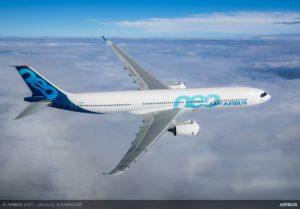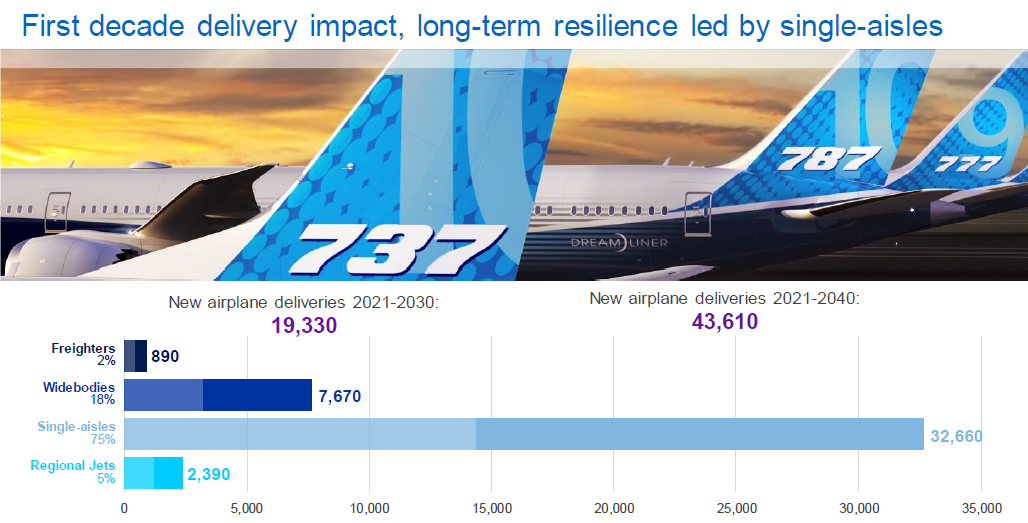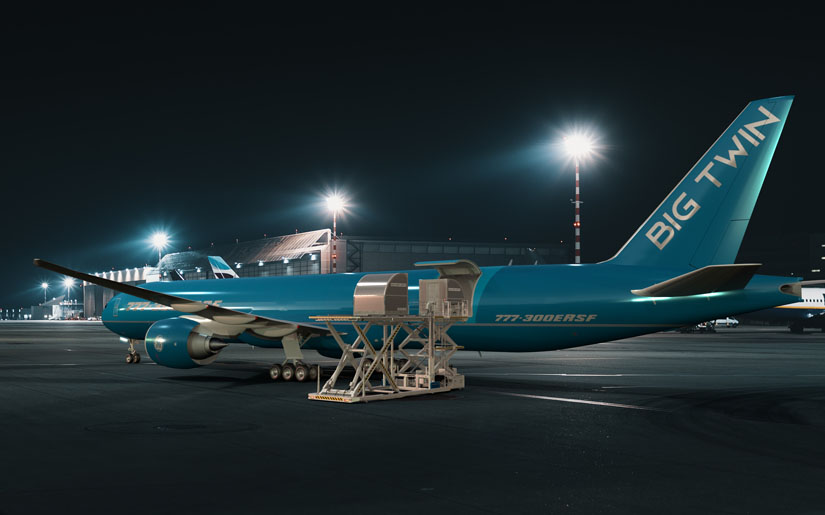Leeham News and Analysis
There's more to real news than a news release.
Pontifications: 8-year old A330-300 converted to freighter, reflects weak market
By Scott Hamilton
Sept. 20, 2021, © Leeham News: An 8-year-old Airbus A330-300 was converted recently from passenger to freighter configuration by EFW.
Actually, says EFW’s Wolfgang Schmid, the airplane is not quite eight. It is the youngest A333 to be converted.
I can’t remember an airplane of any type this young being converted from passenger to freighter. The market value of an eight-year-old aircraft is way too high. Operating economics are well within airline requirements at this age. Aircraft historically become conversion candidates no sooner than 15 years of age and more commonly not before 20.
Behind the latest Boeing CMO
Subscription Required
By Vincent Valery
Introduction
Sept. 20, 2021, © Leeham News: Boeing Commercial Airplanes (BCA) released its latest Commercial Market Outlook (CMO) last week. While the latest total 20-year outlook for commercial aircraft remains below 2019 (43,610 vs. 44,040), it increased by 500 units compared to the previous year.
BCA highlights the headline number of aircraft deliveries to point out the bright long-term growth prospects for the commercial aviation market. The report states that the COVID-19 pandemic erased two years’ worth of growth but did not materially affect long-term prospects.
The delivery figures rely on a large number of assumptions, including market segment and region. LNA takes a deeper look at those assumptions, notably regarding delivery and production rates.
Summary
- Converting to more understandable metrics;
- Assessing the impact of slower 2021 deliveries;
- Plausibility of twin-aisle prospects for the 2020s;
- Can production follow?
Bjorn’s Corner: The challenges of airliner development. Part 21. Production Certificate
September 17, 2021, ©. Leeham News: Last week, we looked at the Production facilities and tooling. In order to bring in revenue, we need to deliver aircraft.
But to have the right to deliver aircraft we need a Production Certificate in addition to our Type Certificate for the design. We need to start the work to get a Production Certificate well before we flight test the aircraft and complete the type certification work, Figure 1.
Is cargo capacity deciding passenger airliner choice?
Subscription Required
By Vincent Valery
Introduction
Sep. 16, 2021, © Leeham News: LNA has so far compared the performance of both factory and converted freighter aircraft. We will continue the cargo-themed series by analyzing how cargo capacity might decide what passenger aircraft airlines buy.
LNA has extensively discussed Airbus and Boeing’s struggles in accumulating orders for their larger aircraft, the A350-1000, and 777X. However, as seen in a recent article, smaller twin-aisle airplanes face skinny order books as well.
One could think that the COVID-19 pandemic would lead airlines to down-gauge their twin-aisle orders to the smallest available variants, the Airbus A330-800 and Boeing 787-8. Such moves make sense at face value to accommodate a reduced demand in passenger traffic.
So far, only Singapore Airlines has converted two 787-10 orders to the 787-8. Instead of down-gauging, American Airlines converted a portion of its 787-8 order to the larger 787-9. Condor recently announced replacing its aging 767-300ER fleet with A330-900s instead of opting for smaller aircraft.
We now investigate whether airlines’ decision not to down-gauge their twin-aisle order books to the smallest variants has to do with a reduction in cargo capacity.
Summary
- A drought of small twin-aisle orders;
- Airline conundra on choosing best variant;
- Comparing cargo capacity of in-production passenger aircraft;
- Setting the analysis framework.
Boeing; 20-year aircraft demand back to pre-pandemic level
By Bjorn Fehrm
September 14, 2021, ©. Leeham News: Boeing released its yearly commercial aircraft demand forecast today. Over the next 20 years, the demand for single-aisle aircraft is past pre-covid levels at more than 32,000 aircraft, with widebodies down 8% compared to 2019 at 7,500 aircraft, Figure 1.
The forecast for freighters is up at 890 aircraft making a total of 43,600 aircraft until 2040, the level of the 20 years forecasts before the pandemic.
Pontifications: How Airbus maneuvered Boeing into launching a re-engined 737
Sept. 13, 2021, © Leeham News: Tomorrow night the US PBS network broadcasts an hour-long special examining the Boeing 737 MAX crisis.
Here is a preview. Afterward, the show will stream on PBS’s Frontline website.
I sat for a long interview for the investigation, which was a combination of reporting by Frontline and the New York Times. I haven’t previewed the show, so I don’t know how much of my interview—if any—survived the editing. But one area of the focus of the interview was how Boeing came to develop the MAX.

Air Wars is available here.
Following the crashes of Lion Air and Ethiopian Airlines five-month-old MAXes, one of the allegations that emerged was that Boeing rushed the development of the airplane.
It’s true that Boeing decided within two days to launch the MAX program. It’s not true that development was “rushed,” in the most common use of the word. Boeing developed what became known as the MAX in parallel with an entirely new airplane concept that would have replaced the 737 Next Generation airplane. It’s what Boeing does: study two or more concepts as engineers and the executives decide what the next airplane will be.
The basic design was on the shelf, ready to go when Airbus forced Boeing’s hand on the cusp of a huge order from American Airlines for the A320ceo/neo family. When Boeing learned of this, the decision was rushed, within two days, to launch the re-engined 737 rather than a new airplane design.
In my new book, published Sept. 1, Air Wars, The Global Combat Between Airbus and Boeing, I outline just how the MAX came to be and how Airbus maneuvered Boeing into launching the program. The book is available globally on Amazon here.
Here is an excerpt from Chapter 1, one of three chapters about the neo-MAX development.
C919 EIS target year end; production rate forecast is aggressive
Subscription Required
By Scott Hamilton
Introduction
Sept. 13, 2021, © Leeham News: The first COMAC C919 is supposed to be delivered to China Eastern Airlines before the end of the year.
If so, it will be the milestone of the program launched in 2008, 13 years ago, becoming one of the longest launch-to-EIS in aviation history. COMAC’s ARJ 21 took one year longer. This regional airliner program was launched in 2002. Entry-into-service was in 2016.
The C919 is China’s direct challenge to the Airbus A320 and the Boeing 737. Similar in appears to the A320, for which there is an assembly line in Tianjin, the C919 is powered by the CFM LEAP 1C and a domestically-produced engine. But the C919 only has an advertised range of 2,200-3,000nm. The A320 and 737-8 have ranges of 3,500 and 3,550nm, respectively.
COMAC forecasts producing 150 C919s a year by the middle of this decade. Achieving this rate in this period should be a major challenge. Based on normal learning curves, a more realistic ramp up to 150 a year will take until early 2031.
Summary
- China forecasts a production rate of 150/yr by the middle of the decade.
- History suggests a much lower rate by then.
- LNA’s production rate forecast is detailed through 2030.
Bjorn’s Corner: The challenges of airliner development. Part 20. Production site and facilities
September 10, 2021, ©. Leeham News: Last week, we looked at the Rig design and manufacture for ground and flight testing.
We are now at the stage in our program (Figure 1) where we shall have scouted and deliberated over our Final Assembly production site (Violet bars). We now need to decide on the site and what facilities we need to build and/or hire.
Is the Bedek 777-300ERSF freighter a threat to the 777F?
Subscription Required
By Bjorn Fehrm
Introduction
September 9, 2021, © Leeham News: In our series on freighters, we now look at the new large conversion freighter from GECAS and IAI Bedek, the 777-300ERSF. How much of a threat will it be to Boeing’s largest freighter, the 777F, when it enters the market next year?
The 777F has the dimensions of the 777-200LR, whereas the 777-300ERSF is a P2F conversion from the larger 777-300ER. What does it mean for cargo payload and volume, and what are the differences in operational economics?
Summary
- The 777-300ERSF freighter will be the volume leader among large freighters.
- IAI Bedek has also worked hard to increase the weight capability. How close can it get to the heavy lifting 777F?






